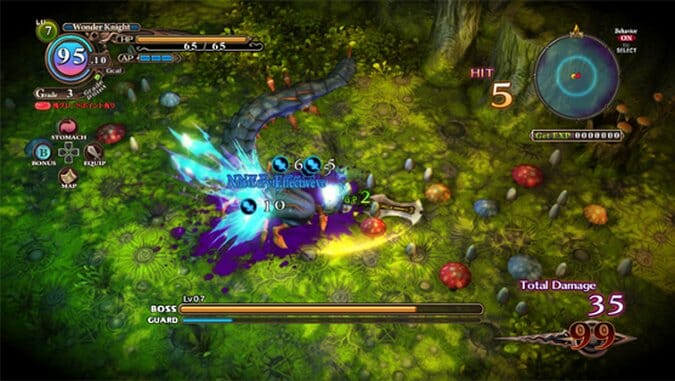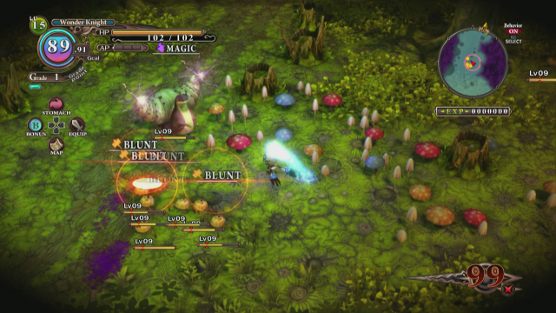
Some games are the best because they are just exactly and powerfully one single beautiful amazing thing, but The Witch and Hundred Knight is more like the Best Super Nintendo Game Ever. That means it is a game that is filled up and down and in every corner with countless hopelessly charming little beautiful amazing things.
The former type of game is suitable for people who have either one billion or one hundred dollars to make a game, either as the result of an individual’s singular vision or the harmony of hundreds of people polishing a gleaming AAA machine. The Witch and Hundred Knight resembles a Super Nintendo game in that it has a small-but-not-too-small team with a fair-but-not-huge budget working with limited technology. It is not like a Super Nintendo game in that the designers have clearly played games made in the last ten years and paid very close attention to them. So Witch and the Hundred Knight gets the best of both worlds. Nippon Ichi Software has historically proven to be very, very good at making tactical RPGs, a skill which they somehow have been able to brilliantly apply to this action RPG, while also making it feel as good and physical and fast and fun as your God Hands or Devil May Crys or Bayonettas.
The game opens with the Hundred Knight as a cute and very pathetic little one-eyed blob looking very confused and lost under the terrifying gaze of the witch’s narrow eyes which glare down at it from the top of the screen. In the first few seconds, the game has established the relationship between the protagonist (slightly cute and slightly evil) and the protagonist’s boss (extremely evil and extremely snarky). You get to pick a name for the Hundred Knight, but the witch promptly ignores it, though she admits it’s really hard to think up a good name right on the spot like that, which is one of the driest meta I have endured in a tutorial while still not leaning into fourth wall-breaking gimmicks too much (something Nippon Ichi has a tendency to do, so it is nice to see them take a break from that). Witch and the Hundred Knight also goes much easier on anime elements, and it is probably the least anime anime game I have reviewed here. There’s a bit of European comics in the aesthetic and the setting, and the grim humor feels driven by the selfish and whimsical personalities of the strange and eccentric magical beings that inhabit this world. That is to say, this is humor based off people—which is pretty rare in games.
The fresh humor in Witch and the Hundred Knight is helped by being straightforwardly playful but also by being a little wicked and evil and dark. The Witch Metallia, who for copyright reasons is definitely not named Metallica, is foul-mouthed, arrogant, and intensely powerful, but she can’t leave her swamp home, so she has summoned a familiar, the legendary Hundred Knight, to spread her swamp across the world. She’s isolated, except for her passive-aggressive Frankensteinian butler, and she doesn’t actually know what she’s doing except that she wants to conquer the world. But, a note: sometimes she goes way, way too far, and it gets kind of unnecessary and uncomfortable. This game is about witches, so it makes a certain amount of sense that the game is about powerful women being awful to each other, but there’s some tone mismatch here that gets ugly.
The little knight, by contrast, with arms too big for its body that drag behind it as it trots about, is the kind of mascot character one might expect to see in ‘90s gaming, except it looks more like an evil ghost than a radical anthropomorphic animal or product placement. The Hundred Knight is completely innocent, starting the game too stupid to respond to anything except with affirmation or ignorance. Later on, it becomes smart enough to say no or be difficult and ask annoying questions, which play a big part in the story and the morality system. The morality system is, for once, skewed in the direction of evil, as that is decidedly what the witch is, and the little minion is there to beat up monsters and terrorize innocent villagers (like most RPGs, you can enter the homes of strangers, but unlike most games, if you want to take random stuff you have to beat up the citizens for it).
The actual game called Witch and the Hundred Knight plays out like—maybe the closest example is console Diablo with some roguelike and Dark Souls elements. The UI looks tasteful but is nonetheless full of an incomprehensible number of things, like you do in a Nippon Ichi game. At the same time, every little thing about Witch and Hundred Knight is actually pretty simple in practice.
First is the time limit, but it’s more like an action limit, because even though it constantly decreases, it decreases more when you do things. To put it another way, you can stop doing stuff and survive for longer. Of course, it is doing stuff—like killing enemies and getting experience and items and points—that is the reason you are out in the first place, and here is where some of that brilliant Dark Souls delayed gratification comes in: you don’t get any of the items or experience or anything until you exit the level alive, and you lose all of it when you die. But! The longer you are out, the more points you get, which will give bonus items and money off of a list when you leave the level, and you’ll also get points that can be used to give temporary upgrades to your stats as long as you are still out on a run. You become stronger and wealthier as the stakes get higher and you have more and more to lose.
The actual play of the game is simple compared to those God Hands and Bayonettas, but it is as exactly physical and fun. The weapons are huge and cartoony and smack as satisfyingly on the enemies as big comic book sound effects. You basically make your own combos by equipping up to five weapons, which are used in that order and have different animations: a staff that shoots a projectile, a lance that spins around, a spear the jabs forward, etc. Much of Disgaea and Diablo’s influence can be seen in the many tiny ways the weapons can be optimized and upgraded and the numerous variants you can hunt down to make each piece exactly how you want.
However, no action game is Actually Fun unless it has a fun way to defend. Moving in position and hitting something gets really boring if there is nothing that stops you from doing that and no way to avoid getting hit. Here, there is both a really good defend (one that is actually worth using) and a rolling dodge that will slow down time a la Bayonetta when done right, which gives a huge opportunity for counterattack. Really, this is all I need for a game to go from mindlessly whacking enemies for loot to genuinely fun and interesting!
Much like Disgaea, so many of the systems in this game require only the slightest attention from the player. They can be optimized or ignored, and the game is still entirely playable—either through twitchy reflexes or gear optimization or some combination. It doesn’t expect or ask you to waste time on anything that’s not interesting to you, though I know the presence of so much stuff can feel very overwhelming to some. It’s easy to take it as it comes and to ignore what you don’t care about. You can get lots of levels and overwhelm your enemies, or get good at optimizing the system, or just be good at attacking and dodging. The game gives you permission to ignore all of the crap you don’t care about, allowing you to be great at the game by participating in however much of it you want. It’s clearer and yet more customizable than pretty much any other action RPG, including that Diablo game, and for that and many reasons other reasons I might whisper to my orchid in the middle of the night when no one is listening that “Witch and the Hundred Knight is better than Diablo III” … but don’t tell anyone that unless they’re also friends with my orchid.
The Witch and the Hundred Knight was developed by Nippon Ichi Software and published by NIS America. It is available for the PlayStation 3.
Aevee Bee is freelance writer who maintains a surreal video game terror blog at mammonmachine.com and a twitter account, @mammonmachine, which is both a popular resource for anime puns and flirtation advice.
